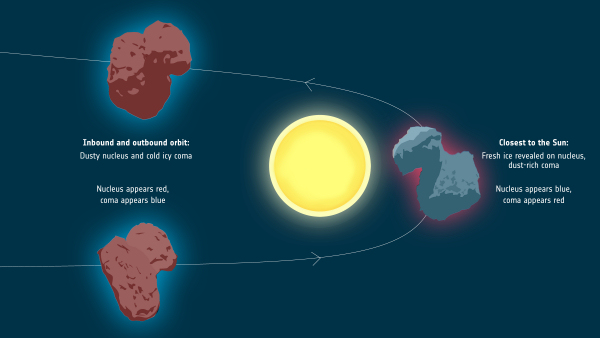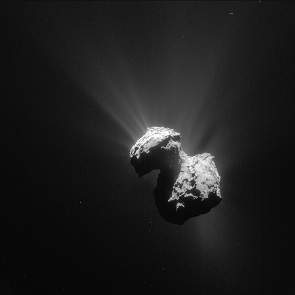Rosetta and the chameleon comet
5 February 2020
A grand synthesis of Rosetta data has shown how its target comet repeatedly changed colour dur-ing the two years it was watched by the spacecraft. The chameleon comet's nucleus became progres-sively less red as it made its close pass around the Sun, and then red again as it returned to deep space. |
| Colour changing comet. Credit: ESA |
Just like a chameleon changes its colour depending on its environment, so too did comet 67P/Churyumov-Gerasimenko. Unlike a chameleon, the colour changes on 67P/C-G reflect the amount of water ice that is exposed on the surface and in the surroundings of the comet.
At the beginning of Rosetta's mission, the spacecraft rendezvoused with the comet while it was still a long way from the Sun. At such distances, the surface was covered in layers of dust and little ice was visible. This meant the surface appeared red when analysed with the VIRTIS (Visible and Infrared Thermal Imaging Spectrometer) instrument.
As the comet drew closer it crossed an important boundary, known as the frost line. Occurring at a distance around three times further from the Sun than the Earth, anything within the frostline will be heated sufficiently by the Sun that the ice will turn into a gas, a process called sublimation.
 |
| Comet 67P/C-G on 7 July 2015. Credit: ESA/Rosetta/NAVCAM, CC BY-SA IGO 3.0 |
As Rosetta followed 67P/C-G across the frostline, VIRTIS began to notice the colour of the comet change. As the comet approached the Sun, the heating increased and the hidden water ice began to sublime pushing away the dust grains too. This revealed layers of pristine ice, which made the nucleus turn bluer in colour as seen by VIRTIS.
Around the comet's nucleus, the situation was reversed. When the comet was far from the Sun, there was little dust surrounding the comet, but what there was contained water ice and so appeared bluer. This surrounding dust cloud is called the coma.
As the comet crossed the frostline, the ice in the dust grains surrounding the nucleus sublimed quickly, leaving just the dehydrated dust grains. And so the coma turned redder as it approached perihelion, its closest approach to the Sun.
Once the comet was heading back into the outer solar system, VIRTIS showed the colour situation reverse again, so the nucleus became redder and the coma bluer.
To track the way the comet evolved, the VIRTIS team had to analyse more than 4000 separate observations spanning across two years of the Rosetta mission.
"To answer the big question of how does a comet work it is very important to have a long time series such as this," says Gianrico Filacchione from Italy's INAF-IAPS Istituto di Astrofisica e Planetologia Spaziali, who led the study.
The reason is that comets are extremely dynamic environments. Jets tend to swiftly appear on their surfaces and then decrease just as suddenly. Therefore, comparing occasional snap shots risks our understanding of the comet's long-term evolution being biased by the transient changes. Having such a large quantity of measurements, however, means that even short timescale changes can be tracked.
"The correlation of what is happening on the nucleus is something completely new that cannot be done from Earth," says Gianrico.
This is because ground observations cannot resolve a comet's nucleus, which in the case of 67P/CG is only about 3 km in size. Now that the team can describe and understand both the long-term evolution of the comet, and the steps it took along the way, it means that the readings from the other instruments onboard Rosetta can be placed into context.
But that does not mean we know everything about comets. Spectral analysis shows that the red colour of the dust is created by so-called organic molecules. These are molecules made of carbon, and there is a rich variety of them on the comet. Scientists believe that they are important for understanding how life formed on Earth.
In order to study them up close and identify these molecules, however, would require a sample of the comet's surface to be returned to Earth. "Bringing back to Earth a piece of the comet is really the Holy Grail for a cometary mission," says Gianrico.
Until that is possible, however, he will continue to use the VIRTIS data to investigate 67P/C-G's organics.
"There are definitely more exciting results to come," says Matt Taylor, ESA Project Scientist for Rosetta, "The data collection may be over, but the analysis and the results will continue for years yet, adding to the rich legacy of cometary knowledge provided by Rosetta."
Notes for editors
"An orbital water-ice cycle on comet 67P from colour changes," by G. Filacchione et al. is published in Nature.
For more information please contact:
Gianrico Filacchione
INAF-IAPS, Institute for Space Astrophysics and Planetology, Rome, Italy
Email: gianrico.filacchione![]() inaf.it
inaf.it
Fabrizio Capaccioni
VIRTIS Principal Investigator
INAF-IAPS, Institute for Space Astrophysics and Planetology, Rome, Italy
Email: fabrizio.capaccioni![]() iaps.inaf.it
iaps.inaf.it
Matt Taylor
ESA Rosetta project scientist
European Space Agency
Email: matt.taylor![]() esa.int
esa.int


